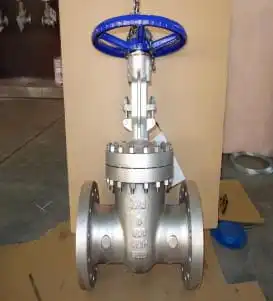Gate valves are sometimes used for regulating flow, but many are not suited for that purpose, as they are designed to be fully opened or closed. They are used when a straight-line flow of fluid and minimum flow restriction are needed. When fully open, the typical gate valve has no obstruction in the flow path, resulting in very low friction loss. Gate valves are not suitable for throttling purposes. The control of flow is difficult because of the valve’s design, and the flow of fluid slapping against a partially open gate can cause extensive damage to the valve. Except as specifically authorized, gate valves should not be used for throttling.
Gate valves are characterized as having either a rising or a non-rising stem. Valves with rising stems are used when it is important to know by immediate inspection whether the valve is open or closed and when the threads (stem and gate) exposed to the fluid could become damaged by fluid contaminants. In this valve, thestem rises out of the valve when the valve is opened. Non-rising stems are used where vertical space is limited or underground. The stem is threaded into the gate. As the hand wheel on the stem is rotated, the gate travels upward or downward moves by the threads while the stem remains vertically static. This type of valve will almost always have a pointer indicator threaded onto the upper end of the stem to indicate the position of the gate.
Bonnets provide leak-proof closure for the valve body. Gate valves may have a screw-in, union, or bolted bonnet. Screw-in bonnet is the simplest, offering a durable, pressure-tight seal. Union bonnet is suitable for applications requiring frequent inspection and cleaning. It also gives the body added strength. Bolted bonnet is used for larger valves and higher pressure applications. Another type of bonnet construction in a gate valve is pressure seal bonnet. This construction is adopted for valves for high-pressure service, typically in excess of 15 MPa (2250 psi). The unique feature about the pressure seal bonnet is that the body-bonnet joint seals improve as the internal pressure in the valve increases, compared to other constructions where the increase in internal pressure tends to create leaks in the body-bonnet joint.
Gate valves normally have flanged ends which are drilled according to pipeline compatible flange dimensional standards. Gate valves are typically constructed from cast iron, cast carbon steel, gun metal, stainless steel, alloy steels, and forged steels.

